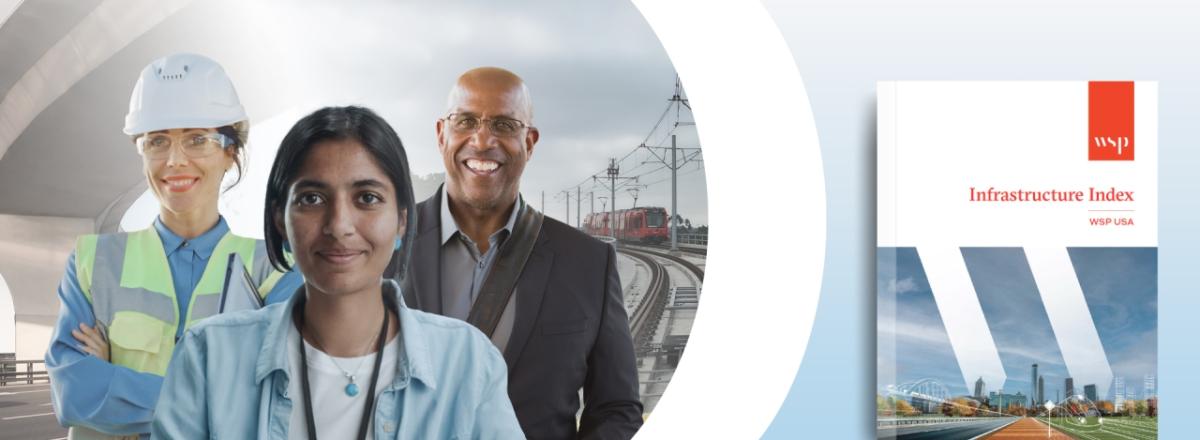WSP Infrastructure Index: 80 Percent of Americans Support Equity in Infrastructure Spending Over Improvements in Their Own Communities
New survey in partnership with The Harris Poll reveals 86 percent of Americans also favor spending more on quality infrastructure rather than realizing near-term savings.

WASHINGTON, May 31, 2022 /3BL Media/ - WSP USA, a leading engineering and professional services consultancy, today released its new WSP Infrastructure Index that gauges Americans’ views on how the Biden Administration’s $1 trillion Infrastructure Investment and Jobs Act, should be spent.
Launched during Infrastructure Week, the report found that a large majority of Americans are concerned about three issues: safety on poorly designed and/or maintained roads and bridges (86 percent); want their community to invest more money now in quality infrastructure that will stand the test of time (86 percent), and believe every community should have access to quality infrastructure even if it means their community would get less funding so other communities can catch up (80 percent).
Other notable findings include:
- Older generations are more likely to prioritize equity. Boomers (85 percent), Gen X (80 percent), Millennials (79 percent) are more likely than Gen Z (67 percent) to believe every community should have access to quality infrastructure even if it means their community would get less funding so other communities can catch up.
- Older generations are more likely to prioritize infrastructure projects that promote sustainability. Compared to younger age groups (ages 35-64), people age 65+ are more likely to prioritize infrastructure projects that will make communities more sustainable and/or climate resilient.
- Most Americans prioritize the public good over projects close to home. A majority of Americans (57 percent) believe that among the top priorities for infrastructure, spending should be focused on projects that are most urgently in need of repair, no matter where they are located – putting the public good significantly ahead of projects nearest their home (15 percent).
“The Infrastructure Investment and Jobs Act provides an unprecedented opportunity to improve the lives of millions of people, yet we found that nearly half of Americans feel they don’t have enough of a say in how infrastructure budget is spent in their community,” said Lou Cornell, WSP USA president and CEO. “With the WSP Infrastructure Index, we hope to provide insight into the priorities and concerns of people around the country, enabling decision-makers and planners to engage even more effectively. It is one way we are acting on our vision and commitment to help create more equitable, sustainable and Future Ready® communities.”
The WSP Infrastructure Index uncovered striking differences in how women and men view some key infrastructure issues. Women are less likely than men to feel they have enough of a voice in how infrastructure budget is spent in their community (44 percent vs. 52 percent) , are less optimistic about the current state of infrastructure in their communities with only 65 percent saying their community has the right quality infrastructure needed for their economy to grow (compared to 72 percent of men), and are less likely to trust their local government to spend infrastructure budget on what is most needed (57 percent vs. 64 percent of men).
While a majority of Americans said they trust their local government to spend the infrastructure budget on what is needed most, urban dwellers (66 percent) are more likely than those in suburban (57 percent) or rural (56 percent) communities to express that confidence.
The report appears to highlight rural Americans’ concern about being left behind. Only 61 percent agreed that their community has the “right quality infrastructure for the local economy to grow” vs. 70 percent of their urban and 71 percent of their suburban counterparts. Rural residents are the only geographic group without a majority (43 percent) agreeing that their community generally gets a fair share of funding for infrastructure. Additionally, only 38 percent of rural residents say they have enough of a say in how the infrastructure budget is spent in their community, compared to 58 percent of their urban counterparts.
One unifying factor is concern about the lack of sustainable and rapid transportation via rail, which garnered majority support from Americans (64 percent) regardless of income levels, race and ethnicity, gender and geography.
Infrastructure includes roads, bridges, public transit, ports and airports — as well as public water, the electric grid, and broadband internet, issues which were explored in the report. The complete WSP Infrastructure Index is available here.
About the WSP Infrastructure Index
The WSP Infrastructure Index is based on a survey conducted online within the U.S. by The Harris Poll on behalf of WSP from April 26-28, 2022, among 2,069 adults ages 18-up. The sampling precision of Harris online polls is measured by using a Bayesian credible interval. For this study, the sample data is accurate to within + 2.8 percentage points using a 95 percent confidence level.
About WSP USA
WSP USA is the U.S. operating company of WSP, one of the world's leading engineering and professional services firms. Dedicated to serving local communities, we are engineers, planners, technical experts, strategic advisors and construction management professionals. WSP USA designs lasting solutions in the buildings, transportation, energy, water and environment markets. With more than 12,000 employees in 200 offices across the U.S., we partner with our clients to help communities prosper. wsp.com

